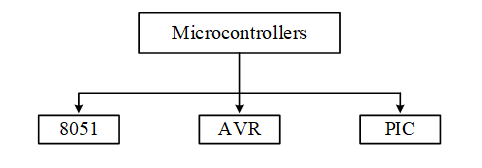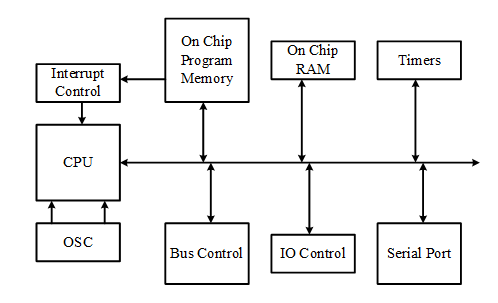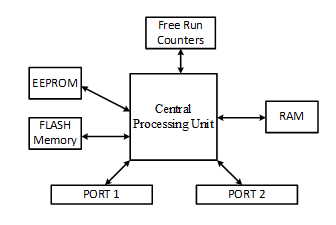Types of Microcontrollers (2021)
06/06/2021, hardwarebee
In today’s world, most of the appliances as well as industrial controls are being automated. To make the systems work independently, an efficient control system is needed. Microcontrollers fulfil the need of a control system. This control system has all the features which can handle a small-scale automation system.
As we know that different applications may require different types of microcontrollers depending on the requirements like memory, number of interfacing devices, processing speed etc. So, this article provides an overview of different types of microcontrollers, what is the difference between different types of microcontrollers and which applications can be targeted using different microcontrollers.
Types of Microcontrollers
Microcontrollers are classified according to their bus width, instruction set, and memory structure. For the same family, several forms from different sources may exist. This article will go through some of the fundamental categories of microcontrollers that newer users may not be aware of. Figure 1 shows some basic types of Microcontrollers.
Figure 1: General Types of Microcontrollers
8051 Microcontroller
In 1981, Intel introduced the 8051 microcontroller. The 8051 microcontroller is a 40-pin integrated device with a dual inline package (DIP), RAM-128 bytes, ROM-4kb, and 16-bit 2 timers. It has four parallel 8-bit ports that are addressable and customizable to meet the needs. Because it connects all devices to the central processing unit, the system bus is crucial in the 8051-microcontroller design. An 8-bit data bus, a 16-bit address bus, and bus control signals build this system bus. The system bus can also be used to connect other components such as ports, memory, interrupt control, serial interface, the CPU, and timers.
In the 8051-microcontroller, Vcc is linked to pin 40 and Vss is linked to pin 20, which is maintained at 0V. There are also input and output ports ranging from P1.0 to P1.7, including an open-drain functionality. Port3 offers additional features. Pin 36 is open-drain, whereas pin 17 is an internally pulled-up transistor inside the microcontroller.
When logic 1 is applied to port 1, logic 1 is applied to port 21, and vice versa. Pin9 is linked to a RESET pin coupled with the capacitor. When the switch is turned on, the capacitor begins to charge and RST becomes high. A high signal on the reset pin resets the microcontroller. When logic zero is applied to this pin, the program begins execution from the beginning.
The microcontroller’s programming is quite difficult. Essentially, we create a program in C that is then transformed to machine language that the microcontroller understands.
Architecture of 8051 Microcontroller
The basic architecture of 8051-microcontroller is shown in figure 2.
Figure 2: Block Diagram of 8051-Microcontroller
Features of 8051 Microcontroller
By looking at the block diagram we can list a number of features for 8051 microcontrollers, which include On chip Random Access Memory (RAM), Read Only Memory (ROM), serial ports to communicate with other devices, an option to install external oscillator for various frequency ranges, Times and Counters which can be used to register events, interrupts are also included which can be used make decision based on various events.
AVR Microcontrollers
“Advanced Virtual RISC” is the acronym for the AVR microcontroller, while the MCU is the short name. The Atmel Corporation manufactured AVR Microcontroller in 1996. It has two main architectures: (i) The Harvard architecture which has different busses to control the data and instructions, while (ii) von Neumann has single shared bus for both data and program memory making it work slower. In comparison to other characteristics such as sleep modes6, integrated ADC (a digital converter-analog), internal oscillator and serial data connection, the Microcontroller’s features carry out the instructions in a single running cycle. These microcontrollers have been highly quick and use less power to function in various power saving methods. AVR microcontroller variants are available for various different bit lengths which include 8-, 16- and 32-bit busses, while the variant of AVR family as named as ATmega8, ATmega16, etc.
There are three main kinds of AVR microcontrollers available, including XmegaAVR, MegaAVR, and TinyAVR.
- In demanding applications that need fast speed and enormous program capacity is the Xmega AVR microcontroller.
- Mega AVR microcontroller is renowned for its many integrated components, excellent memory and current applications.
- Tiny AVR microcontroller is utilized for numerous easy purposes.
Atmel AVR Microcontroller Architecture
Figure 3 shows the Block Diagram of the Atmel AVR Microcontroller
Figure 3: Block Diagram of the Atmel AVR Microcontroller
Features of AVR Microcontroller
The features of AVR microcontrollers include an MCU with 8-bit and a high-performance processing, it uses an RISC architecture where it uses single cycle execution, double address instructions and 32 general purpose registers. The AVR can also be programmed while they are On-Chip. These controllers have an efficient Code density for C language and also consumes low power.
PIC Microcontroller
The PIC, invented in 1993 by the generic microelectronics tool, is a peripheral interface controller. PIC is the smallest microcontroller in the world that can be programmed to perform a wide range of work. A circuit wizard software may accomplish this programming and the simulation procedure of the micro-controller. PIC’s microcontroller consists of an IC and has an architecture of CPU, RAM, ROM, timers, counters and protocols such as SPI and UART. Microcontroller applications include industrial applications. This microcontroller offers the benefit of low power consumption, high efficiency, hardware and software instruments like as simulators, compilers, debuggers, etc. PIC microcontrollers are entering new applications such as cellphones, audio accessories, peripherals for video games and sophisticated medical equipment.
PIC Microcontroller Architecture
Figure 4 shows the PIC Microcontroller architecture
Figure 4: PIC Microcontroller block diagram outline
Figure 5: Microcontroller Types
Advantages of Microcontrollers
There are various advantages of microcontroller which allows us to use them for many different applications. Microcontrollers are dependable as well as they can be reused as well. The controllers are small, very cost effective and power efficient. The other positive point about the microcontrollers is the availability of on chip memory like RAM, ROM and I/O Ports which make the interfacing easy.
Disadvantages of Microcontrollers
Besides the advantages of microcontrollers, there are a few disadvantages as well. The programming is a bit complex, but it can be made easier now a days using Arduino. The microcontrollers are electrostatic sensitive and also the interfacing with high power devices is a complex task. The other limitation is that it can only perform operations in sequential manner, only a limited number of executions are possible simultaneously.
Typical Applications of Microcontrollers
There are a huge number of devices which use microcontrollers, mainly because they are easy to include or install in a machine around a project. The main points of focus are as follows:
- Energy Management: Competent equipment measurement assist in home and industrial energy consumption calculation. By incorporating microcontrollers, these systems are competently developed.
- Touch Screens: High levels of manufacturers of microcontrollers include touch sensing capability. Moving gadgets, like media players, gaming gadgets and cell phones are some of the microcontroller’s illustrations combined with touch sensors.
- Automobiles: In the delivery of automotive solutions, the 8051 microcontroller is recognized. They are often used for controlling engine fluctuations in hybrid motor vehicles. Works such as cruise power and antiviral technique have also enabled it to fuse microcontrollers more effectively.
- Medical Devices: Mobile medical gadgets like glucose & blood pressure monitors put micro-controllers into action, therefore supplying greater dependability to produce the right health outcomes.
Further Reading:
Step by Step Guide to Microcontroller Programming
















